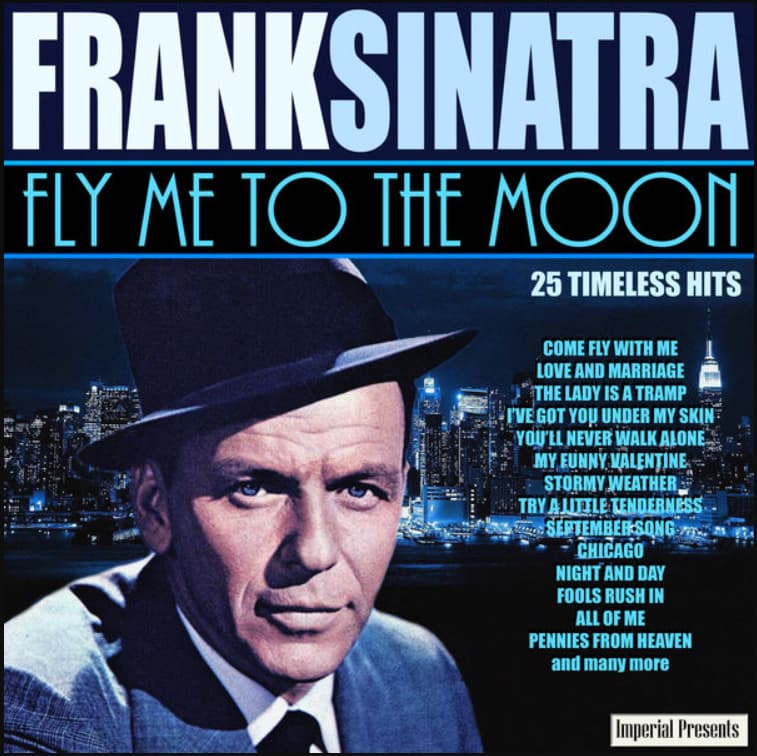
Frank Sinatra – “Fly Me to the Moon”: A Swinging Anthem of Romance and Adventure
Frank Sinatra’s “Fly Me to the Moon” is a timeless jazz standard that captures the excitement and boundless possibilities of love. Originally written by Bart Howard in 1954 under the title “In Other Words”, the song was famously reinterpreted by Sinatra in 1964, becoming one of his most iconic recordings. Released on his album It Might as Well Be Swing, this version—arranged by the legendary Quincy Jones and backed by Count Basie’s Orchestra—adds a lively, swinging jazz rhythm that transformed the ballad into an uplifting anthem of love and adventure. Sinatra’s rendition, with its polished vocal delivery and dynamic orchestration, remains a definitive jazz classic and a symbol of the elegance and charm of the Rat Pack era.
The song opens with a bold, swinging rhythm, driven by Count Basie’s big band arrangement that immediately sets a lively, upbeat mood. The rhythm section, with its syncopated drumbeat and vibrant brass, captures the essence of swing, creating an irresistible groove that feels both joyful and sophisticated. This arrangement gives “Fly Me to the Moon” a sense of forward motion, reflecting the song’s themes of exploration and romantic daring. The energetic brass section and crisp percussion create a sound that is both grand and intimate, making it feel like a celebration.
Lyrically, “Fly Me to the Moon” is a love song that expresses the thrill of romantic discovery and the desire to go beyond earthly boundaries. Lines like “Fly me to the moon, let me play among the stars” and “Let me see what spring is like on Jupiter and Mars” convey a sense of wonder and longing to experience something extraordinary with a loved one. The lyrics are filled with imagery that elevates love to a cosmic scale, capturing the feeling that true love is limitless. This theme of boundless affection and curiosity has made the song resonate with listeners for decades, inspiring a sense of adventure and passion.
The chorus, “In other words, hold my hand; in other words, baby, kiss me”, brings the song back down to earth with a simple yet powerful expression of intimacy. This refrain serves as a grounding moment amid the dreamy, star-filled imagery, reminding listeners of the importance of closeness and affection in love. It’s a line that feels both romantic and sincere, adding depth to the song’s otherwise grand vision. Sinatra’s delivery of these lines is smooth and assured, bringing warmth and authenticity to the lyrics.
Sinatra’s vocal performance is central to the magic of “Fly Me to the Moon.” His voice is effortlessly cool and confident, adding a layer of sophistication and charm to the song’s playful lyrics. Sinatra’s phrasing is masterful, with each line delivered in a way that feels natural and unhurried, as though he’s savoring every word. His voice has a sense of control and ease that makes the song feel like a private serenade, even within the grandeur of the big band arrangement. Sinatra’s delivery balances joy with a touch of sincerity, creating a perfect blend of romance and fun.
The Quincy Jones arrangement is a standout aspect of Sinatra’s version, adding layers of energy and style that elevate the song. The lively brass section, combined with the swinging rhythm and tight coordination of Count Basie’s Orchestra, creates a sound that is both timeless and exhilarating. The band’s dynamic, precise playing gives the song a sense of polish and finesse, while the rhythm section drives the track forward with a steady, infectious beat. This arrangement brings out the best of big band jazz, creating a backdrop that complements Sinatra’s vocals and enhances the song’s sense of celebration.
Since its release, “Fly Me to the Moon” has become one of Sinatra’s signature songs, often associated with his suave, sophisticated style. Its themes of love, exploration, and the joy of experiencing life with someone special have made it a favorite for listeners of all ages. The song’s enduring popularity has kept it relevant across generations, used in films, TV shows, and commercials, and covered by countless artists. It has become not only a jazz standard but a cultural touchstone, representing the elegance and romance of Sinatra’s era.
“Fly Me to the Moon” has also been associated with space exploration, particularly after it was played by NASA astronauts during the Apollo missions, symbolizing the hope and adventure of space travel. This connection has added to the song’s legacy, giving it an association with the spirit of exploration and the idea that love, like the universe, is boundless.
In the end, “Fly Me to the Moon” is more than just a love song—it’s an invitation to dream big, love deeply, and embrace life’s adventures. Sinatra’s charismatic delivery, combined with the lively Quincy Jones arrangement and the timeless lyrics, makes it a song that feels both intimate and grand. For fans of jazz, big band, and classic love songs, “Fly Me to the Moon” remains an enduring anthem of romance, embodying the magic of falling in love and the endless possibilities that come with it.